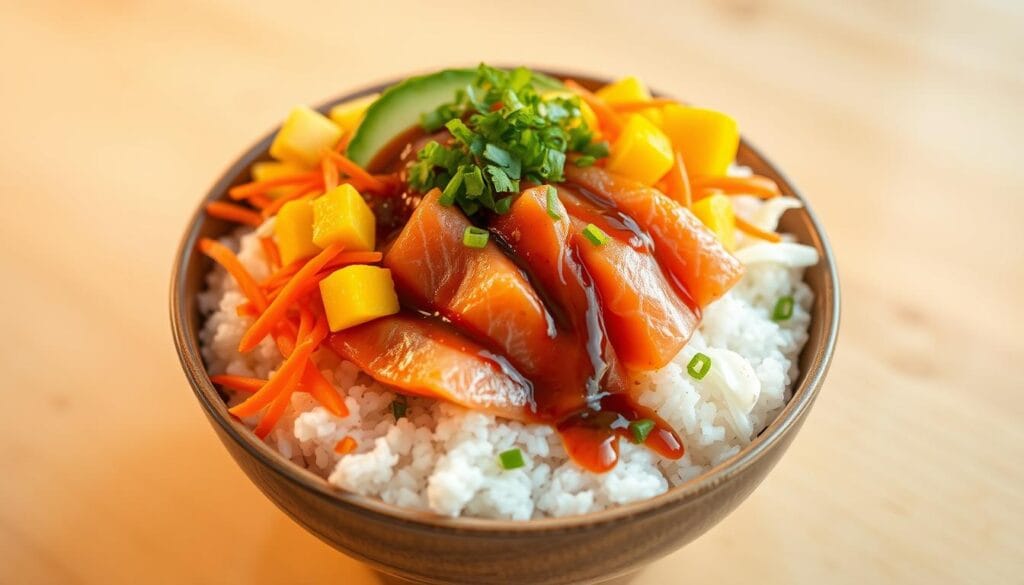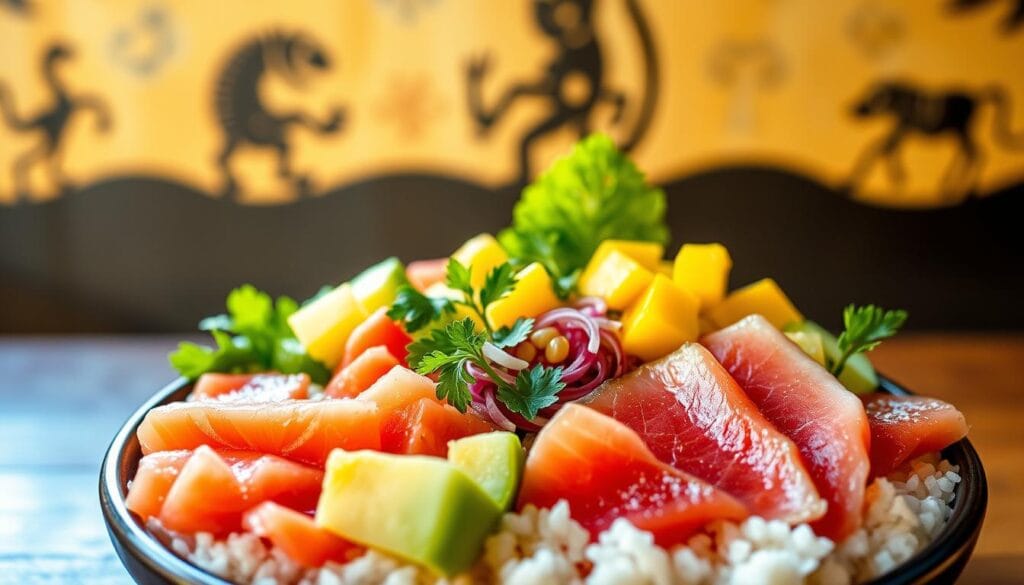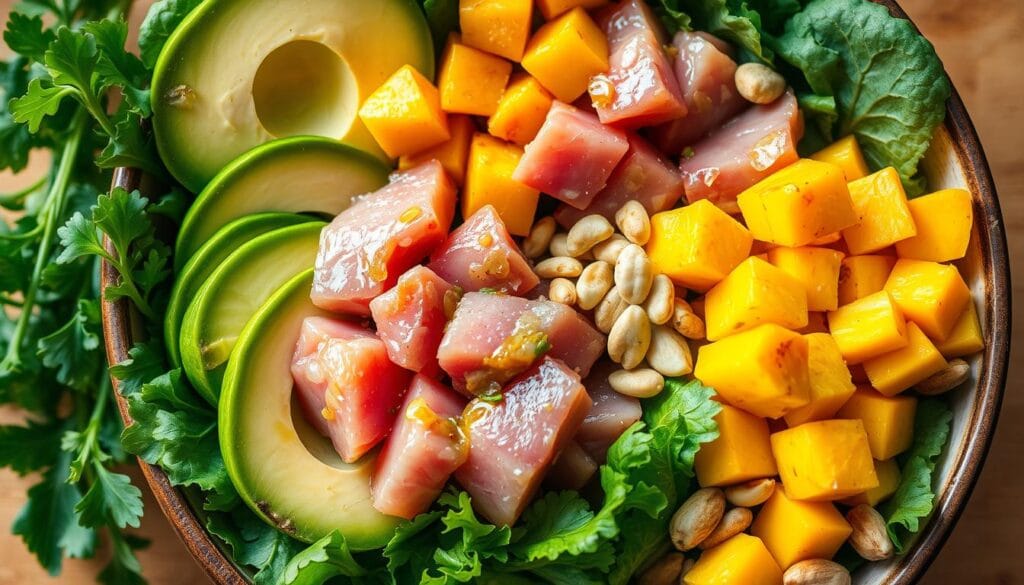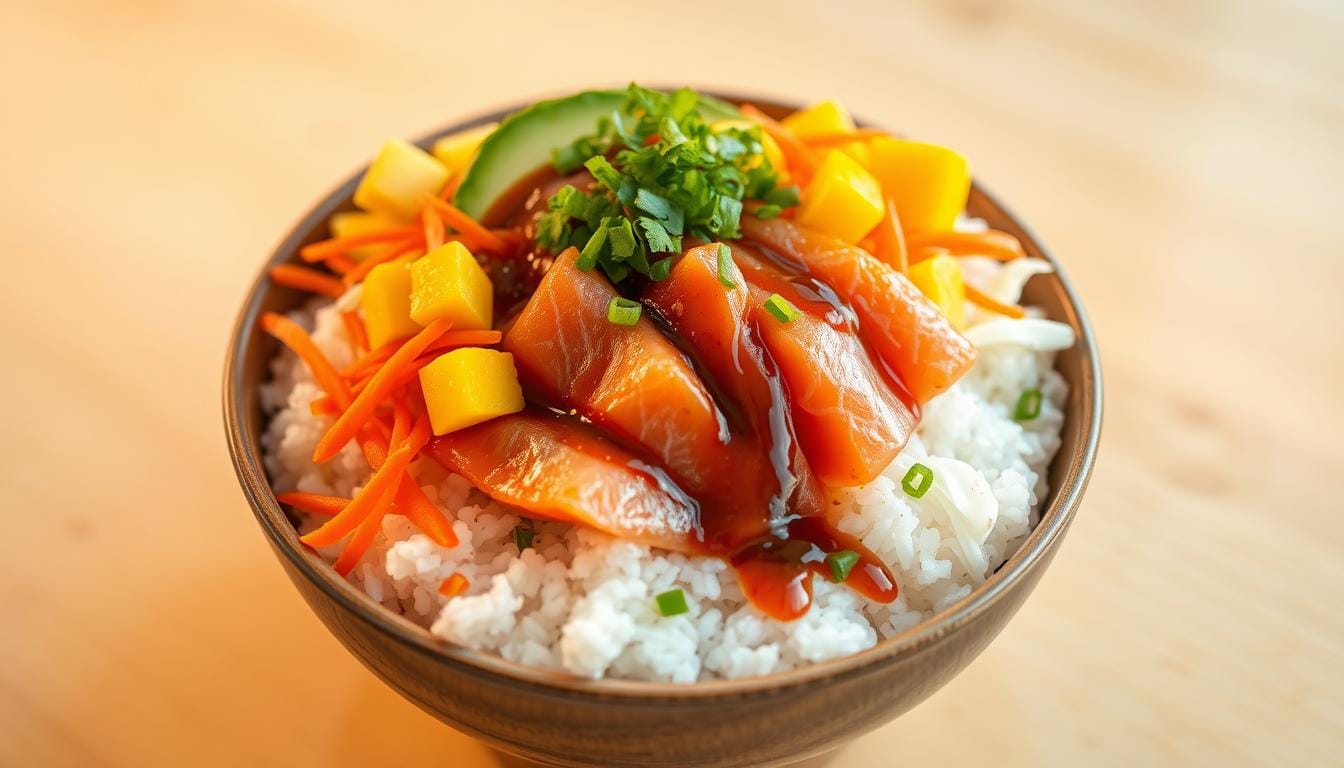Fresh and Flavorful Poke Bowl Recipe for a Healthy Meal
Get ready to explore poke bowls, a dish that’s swept the US with its fresh seafood and endless options. A traditional poke bowl has fresh seafood like tuna or salmon, mixed with tasty sauces. It’s topped with creative ingredients. As poke bowls grow in popularity, people are eager to try new recipes at home.

Whether you love spicy tuna or salmon, there’s a poke bowl for you. Fresh seafood is key, making classic poke bowls a hit. From the West Coast to the East, poke bowls are loved for their taste, healthiness, and fun.
Key Takeaways
- Poke bowls are a popular dish that originated in Hawaii and have since spread throughout the United States
- A traditional poke bowl recipe typically consists of fresh seafood, flavorful sauces, and creative toppings
- Poke bowls are highly customizable, making them a great option for people with different tastes and dietary preferences
- Fresh seafood is a key component of a traditional poke bowl recipe
- Poke bowls are a healthy and delicious meal option that can be enjoyed at home or in a restaurant
- With the right ingredients and a little creativity, you can create your own unique poke bowl recipe at home
The Origins and Evolution of Poke Bowls
Poke bowls are now a big hit in food trends, but they started in ancient Hawaii. The word “poke” means “to slice or cut” in Hawaiian. This refers to how they traditionally cut raw fish. Over time, this dish has grown, adding new cooking techniques and ingredients while keeping its core.
In Hawaii, poke was once just raw fish, salt, and seaweed. But as different cultures arrived, new ingredients and cooking techniques were added. This changed the dish into the varied and tasty bowls we love today. Poke bowls show how food trends can change our food world.

- Unique flavors, mixing raw fish’s freshness with savory toppings and sauces
- Health benefits, as poke bowls are rich in protein and omega-3s, appealing to health fans
- Cultural mix and fusion, leading to creative and varied poke bowl styles
As food trends keep changing, it’s exciting to see poke bowls evolve. They will likely add new cooking techniques and ingredients. Yet, they will stay true to their Hawaiian roots.
Essential Ingredients for Authentic Poke Bowls
To make a tasty poke bowl, you need fresh and sustainable ingredients. Choose from fish like tuna, salmon, and shrimp. These are not only delicious but also good for you, making them great for healthy recipes.
Traditional poke bowls include:
- Fresh seafood: tuna, salmon, shrimp, and other types of fish
- Flavorful sauces: soy sauce, sesame oil, and ponzu
- Creative toppings: seaweed, sesame seeds, and pickled ginger
It’s important to use fresh and sustainable ingredients for poke bowls. This ensures the dish is safe and helps the environment. By picking seafood options that are sustainably sourced, you support eco-friendly practices while enjoying your meal.
Poke bowls are also a great choice for healthy recipes. They are packed with protein, low in calories, and full of omega-3 fatty acids. With the right ingredients, you can make a meal that’s both delicious and nutritious.

In summary, the secret to a real poke bowl is in the ingredients. Use fresh and sustainable seafood options and add flavorful sauces and creative toppings. This way, you can enjoy a tasty and healthy recipe for any time.
Must-Try Seafood Recipes for Your Poke Creation
Creating the perfect poke bowl starts with the right seafood recipes. You can try different flavors and textures to find your favorite. From classic ahi tuna to spicy salmon, there’s a lot to choose from. Here are some key poke bowl ingredients and seafood preparation tips to get you started.
Quality seafood is essential for a great poke bowl. You need fresh, sashimi-grade fish. Proper seafood preparation brings out the best flavors. Ahi tuna, salmon, and yellowtail are popular choices, each with its own taste and texture.
- Classic ahi tuna poke, marinated in soy sauce, sesame oil, and green onions
- Spicy salmon poke, mixed with mango and sriracha mayo
- Yellowtail hamachi poke, with pickled ginger and toasted sesame seeds
These recipes show the variety of poke bowl ingredients and seafood preparation methods. They can be tailored to your taste. Whether you’re new to poke bowls or a seasoned fan, these recipes will spark your creativity.
Selecting the Perfect Base for Your Bowl
Creating a tasty and beautiful poke bowl starts with the base. A great base can make the dish more enjoyable. It’s key to pick one that goes well with the seafood and toppings.
When choosing a base, you have rice, noodles, or mixed greens. Each one changes the taste and feel of the bowl. For instance, sushi rice lets the seafood’s flavors shine. Noodles add a fun twist.
Here are some bases you can try:
- Sushi rice
- Udon noodles
- Mixed greens
- Quinoa
Use one or mix them for a unique base. The right base and toppings make your poke bowl look and taste amazing. It’s a great way to show off your food presentation and garnishing ideas.
Fresh Fish Selection and Preparation Guide
Creating delicious poke bowls starts with fresh fish. Seafood safety is key, so we focus on handling techniques to avoid contamination. Choose sushi-grade fish from trusted sources for the best quality.
Proper handling techniques keep the fish safe and fresh. Store it at the right temperature and handle it carefully. This way, you can enjoy your poke bowls knowing they’re safe and of high quality.
Choosing the Right Fish
- Look for fish with a pleasant smell and firm texture
- Check the fish for any visible signs of damage or spoilage
- Choose fish that has been stored and handled properly
Proper Storage and Handling
Keeping the fish safe and fresh is crucial. Store it in the fridge at 40°F (4°C) or below. Handle it gently to avoid damage.
Essential Sauces and Marinades
To make your poke bowl taste better, it’s key to know about marinades and sauces as flavor enhancers. They can either make or break the dish. Soy sauce, wasabi, and sesame oil are must-haves in many poke bowls. Each adds a special flavor.
A great marinade brings out the fish’s natural taste. Sauces add a flavor explosion to every bite. Together, they create a perfect mix of tastes that you’ll love.
- Soy sauce: adds a salty, umami flavor
- Wasabi: adds a spicy kick
- Sesame oil: adds a nutty, aromatic flavor
These ingredients will help you make a tasty and true poke bowl. Marinades and sauces are key in boosting the dish’s flavor.
Creative Toppings and Add-ins
Creating the perfect poke bowl is all about the toppings and add-ins. You can pick from a wide range of options to make your bowl just right. Choose from seaweed and sesame seeds to pickled ginger and wasabi. The secret to a great poke bowl is balancing flavors and textures.
Modern poke bowls often include texture components like crispy fried onions and toasted nuts. These add a nice crunch that contrasts with the soft fish and rice. Some favorite texture components are:
- Crunchy fried shallots
- Toasted sesame seeds
- Crispy fried garlic
- Chopped nuts like peanuts or cashews
Think about the flavor you want when picking toppings. For spice, add jalapenos or serrano peppers. For a milder taste, go with cucumber and carrot. Experimenting with toppings lets you create a poke bowl that’s both tasty and pretty.
Building Your Poke Bowl Step by Step
To make a tasty and pretty poke bowl, follow a simple guide. It’s key to keep the ingredients fresh and safe. Start with a base like sushi rice, mixed greens, or both.
Then, add your protein like sashimi-grade tuna, salmon, or tofu. Arrange it for a balanced look. Next, add your favorite toppings like diced veggies, pickled ginger, and sesame seeds. Remember, keeping the ingredients at the right temperature is important for safety and taste.
Here are some tips for building your poke bowl:
- Choose fresh and sustainable ingredients for the best taste and texture.
- Keep your ingredients at the right temperature to avoid spoilage and foodborne illness.
- Try different toppings and sauces to find your favorite poke bowl.
By following these steps and keeping an eye on temperature, you can make a unique and tasty poke bowl. Always handle and store your ingredients safely to keep them fresh and quality.
| Ingredient | Temperature Control |
|---|---|
| Sashimi-grade fish | Store below 40°F (4°C) |
| Sushi rice | Store at room temperature or below 40°F (4°C) |
| Diced vegetables | Store at room temperature or below 40°F (4°C) |
Health Benefits and Nutritional Information
Poke bowls are great for those who care about their health. They are full of fresh, raw ingredients. This makes them a good source of protein, omega-3 fatty acids, and vitamins and minerals.
When picking ingredients for your poke bowl, think about what you want to get from it. Look for lean proteins like tuna, salmon, and tofu. Also, choose complex carbohydrates like brown rice and quinoa. Don’t forget to add veggies like cucumbers, carrots, and seaweed for extra vitamins and minerals.
- Go for lean proteins to cut down on saturated fats
- Choose complex carbs for lasting energy
- Add lots of veggies for more vitamins and minerals
By picking the right ingredients, you can make a poke bowl that’s both tasty and good for you. It supports your health and meets your dietary needs.
Common Mistakes to Avoid When Making Poke
Making poke can lead to common mistakes that affect the dish’s quality and taste. Avoiding these mistakes is key to a tasty and true poke bowl. Mistakes include overcooking the fish, not seasoning the marinade enough, and mishandling the fish.
To fix these errors, having troubleshooting tips is vital. Here are some tips to steer clear of common mistakes:
- Use fresh and sashimi-grade fish for safety and quality.
- Don’t overmarinate the fish to keep its texture.
- Adjust the marinade seasoning to taste, adding more or less as needed.
By following these tips and watching out for common mistakes, you can make a great poke bowl. Always handle the fish carefully. Don’t be afraid to try new flavors and ingredients to make your poke bowl unique.
Serving and Presentation Tips
Creating a visually appealing poke bowl is key to a great dining experience. The plating and presentation of your poke bowl can greatly enhance the visual appeal of the meal. Start by choosing a bowl that matches the colors and textures of your ingredients.
A well-presented poke bowl can make the dining experience even better. Here are some tips to boost the visual appeal of your poke bowl:
- Balance the ingredients for a harmonious look.
- Use garnishes like sesame seeds or green onions for color and texture.
- Make sure each ingredient is at the right temperature for serving.
By following these tips, you can make a poke bowl that looks as good as it tastes. The right plating and presentation can turn your poke bowl into a masterpiece. It will impress your guests with its visual appeal.
Remember, the presentation of your poke bowl is just as important as the ingredients and flavors. With a bit of creativity and attention to detail, you can make a dish that’s both delicious and stunning to look at.
Conclusion: Mastering the Art of Poke Bowl Creation
Poke bowls have won over food lovers around the world. They started in Hawaii and now are loved everywhere. This dish is not only tasty but also very flexible.
We’ve looked into poke bowls’ history, key ingredients, and how to make them. Whether you’re a poke expert or new to it, you now know more about this dish. This knowledge will make you appreciate poke bowls even more.
Keep trying new and innovative recipes as you make more poke bowls. Poke bowls are great because you can make them your own. This lets you create a dish that’s just right for you.
So, become a poke bowl master and let your creativity shine. There’s so much to try, and you’ll enjoy every bite. Enjoy your poke bowl adventures!
FAQ
What is a poke bowl?
A poke bowl is a dish from Hawaii. It has fresh, raw seafood like tuna or salmon. It’s served over rice or greens with tasty toppings and sauces.
What are the key ingredients in a poke bowl?
A poke bowl has sushi-grade seafood, rice or greens, and avocado. It also includes edamame, diced onion, sesame seeds, and a special sauce. This sauce is made with soy sauce, sesame oil, and seasonings.
Where did poke bowls originate?
Poke bowls come from Hawaiian cuisine. Fishermen used to make a simple dish with raw tuna, soy sauce, and sesame oil. Now, chefs and home cooks add their own twist with different seafood and toppings.
What types of seafood can be used in a poke bowl?
Most poke bowls use ahi tuna. But you can also find salmon, yellowtail, shrimp, crab, or octopus. The seafood should be sushi-grade for the best taste and texture.
How do I properly store and prepare the seafood for a poke bowl?
For safety and flavor, handle and store seafood right. Choose sushi-grade fish and keep it cold or frozen. Cut it into even cubes. Follow food safety rules to avoid contamination.
What types of sauces and marinades are used in poke bowls?
Traditional poke bowls use soy sauce. But you can try spicy mayo, ponzu, ginger-sesame, or mango sauces. These add unique flavors.
What are some creative topping ideas for poke bowls?
Try avocado, edamame, and scallions for classic toppings. But you can also add cucumber, radish, mango, macadamia nuts, furikake, and crispy onions or shallots. These add variety and flavor.
How do I build the perfect poke bowl?
Start with rice or greens as the base. Add marinated seafood, then your favorite toppings. Don’t forget a drizzle of poke sauce and garnishes like sesame seeds or microgreens.
What are the health benefits of poke bowls?
Poke bowls are healthy because they have fresh seafood, avocado, and veggies. The seafood gives omega-3s, while grains and produce offer fiber and vitamins. They’re a balanced and filling meal.
What are some common mistakes to avoid when making poke bowls?
Avoid using low-quality seafood and over-marinating the fish. Don’t overcook the rice and use too many flavors or textures. Always store and handle ingredients safely.
How should I present and serve a poke bowl?
Poke bowls look great in shallow, wide bowls. Arrange ingredients nicely for color and texture. Add fresh herbs, sesame seeds, or a sauce drizzle for a final touch.https://www.recipeskic.com/

